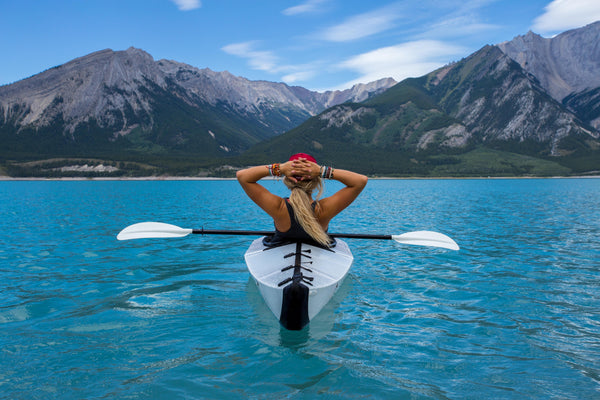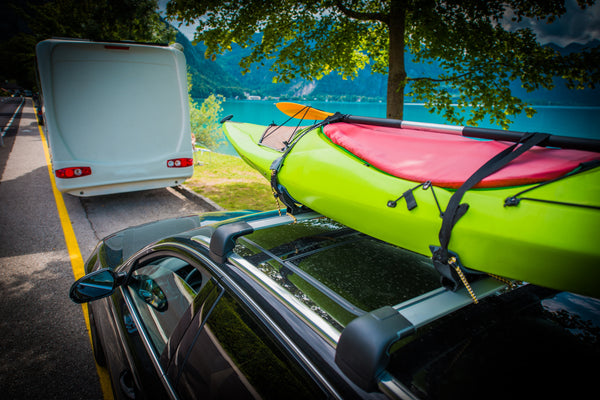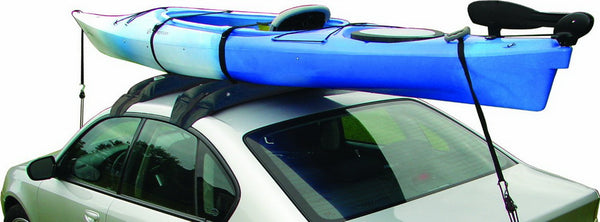How to Tie a Kayak to a Roof Rack
Aug 12, 2019
Originally published Aug. 12, 2019. Updated June 30th 2023.
Though they glide effortlessly through the water, kayaks can be a bit of a handful on land. Once you have negotiated your boat onto the roof of your car, you want to know that everything is securely in place before you start your journey.
Transporting a kayak on the roof of your car doesn’t have to be daunting. Check out our top tips for tying down your kayak, so you drive off with confidence.

Prepare your equipment
Before you start, it is always good to be prepared. That way you won’t have to leave your car or kayak unattended while you run off to grab that rope or strap that is still in your garage! The tie-down essentials are:
- A sound roof racking system
- Padding to protect your kayak and car roof
- x2 purpose-made tie-down straps
- x2 lengths of rope to serve as bow and stern lines
- OR
- x2 further tie-down straps
For sit in type kayaks, we couldn't recommend getting proper kayak carrier cradles to protect and secure your kayak. They slide into your existing roof racks, and are made of rubber, which means they grip your kayaks hull nicely, whilst protecting it from getting warped or dented from your aluminium roof racks. They also do a great job of keeping your kayak from the dreaded sliding side-to-side, often experienced when driving down a highway, which means you won't constantly feel like you need to pull over to check and tighten your straps.
For a comprehensive overview of the equipment outlined above, check out our guide How to Transport a Kayak.
Load your kayak correctly
It is important to evenly distribute the weight of your kayak across the length of your vehicle. This will keep your kayak stable as you’re tying it down as well as when you are driving. Place the widest parts of your kayak over the points where you will be tying it down. By securing the kayak at its widest points, you will avoid it slipping back and forth while you are travelling.

Secure your kayak at the widest part of the boat to avoid slipping
Tie down your kayak
After you have loaded your kayak, you will need to secure it using your tie-down straps. Cam buckle straps are the ideal tie-down as they save you from having to know specific types of knots. They also allow you to adjust the tension of your fastening with ease.

Using a purpose made tie-down strap will save you time and give peace of mind
How you fasten your kayak will depend on the type of roof racks you are using.
Hard-Racks
1. Take the buckle of your cam strap and pass it underneath the crossbar of your rack. Make a ‘U’ with the strap either side of the bar and pass both ends over the top of your boat. For most cars, you will need additional height to pass the strap over. We recommend using a small step-stool for added stability, but you can also stand on the footwell of your vehicle by opening the door. Repeat this process at the second crossbar.
2. Once you have passed both your straps over, walk around to the other side of your vehicle. Make sure your straps have not become twisted or crossed over when you passed them over the top of your boat. Your buckle should rest on the top edge of your kayak.
3. Next, take the end of the strap without the buckle and pass this underneath the crossbar, again making sure you are passing it inside the fixture. Pass the end of the cam strap up to meet the buckle, open the buckle and pass the end of the strap through. Pull gently down on the end of the strap and cinch until secure. Move back and forth between the front and back straps, cinching and adjusting the kayak until it is firmly fastened.

Soft-Racks
Soft-racks, such as the Traveller Soft Roof Racks, will have fastening points to loop the tie-downs through. Follow the same process as with a hard rack but instead pass your straps through these fastening points. These soft roof racks are best suited for sit on top style hulls (such as fishing kayak and recreational kayaks), because of their flat hull which sits flush.

Soft kayak racks will have fastening points for you to loop tie-down straps through
Inflatable Racks
Inflatable Roof Racks require a slightly different tie-down procedure than hard and soft-racks as they do not have fastening points to loop the straps through. Once your kayak is in place on the roof of your vehicle open all the doors of your car. Take the buckle of your cam strap and pass this over the top of your boat. Repeat with the second strap. Each strap should run parallel to the inflatable racks themselves. Go round (or through) the vehicle and grab the buckle and pass it through the open door of your car. If you have a car that does not have back doors you can also pass your straps through the windows! Secure your straps by passing the loose end through the buckle and cinching until it is tight.
Tension, tension, tension
It’s essential to choose the right amount of tension for your boat. Plastic boats are forgiving, you can pull your cam straps as hard as you want! Composite or fibreglass boats are a little trickier. You want to have just enough tension that your kayak is secure, too tight and you risk warping your boat.

Don’t forget the bow and stern lines
Finally, you will want to secure the bow and stern of your boat. To do this you can use another two tie-down straps or, if you’re handy with a Trucker’s Hitch, you can tie your bow and stern lines with lengths of rope.
Take your strap or rope and pass it through the front handle of your kayak and secure in place under the front bumper. Pass a second strap or rope through the back handle and attach to the back bumper. The bow and stern lines do not need to be tensioned like the cross straps. They will prevent the boat from lifting up due to the wind. They will also stop the kayak from flying off the vehicle in the case of an accident.

Secure the bow and stern of your kayak to prevent it lifting while driving
Final checks
Once you have secured your cross straps, bow and stern lines you will need to complete a few checks before departing. Firstly make sure any excess strapping is tucked neatly away as loose straps can impair your view while driving. Next, walk around your car, checking your fastenings are secure.
Remember, when driving with an added load, leave plenty of space between yourself and other vehicles. Avoid braking or accelerating harshly as this will put unnecessary pressure on your fastenings. If you are driving a long distance, make regular stops to complete your final checks.
Safe travelling!
SHOP OUR RANGE OF KAYAK CAR TRAVEL ACCESSORIES HERE

